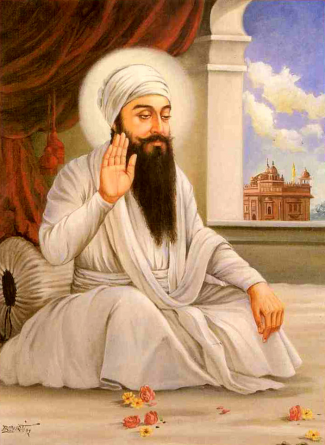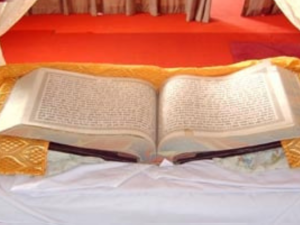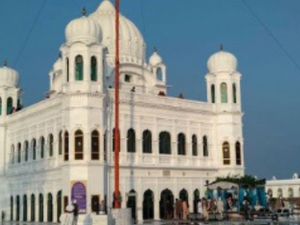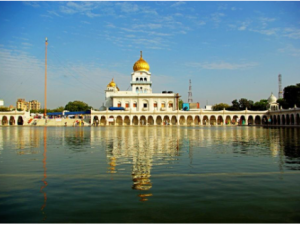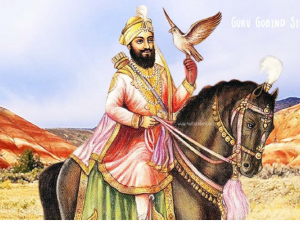Guru Arjan Dev Ji (15 April 1563- martyred 30 May, 1606) was born in Goindval as the youngest son of Guru Ram Das and Bibi Bhani, (daughter of Guru Amar Das).
Guru Arjan, the fifth Guru in succession proved himself to be an original thinker, a famous poet and a philosopher, erudite scholar, great organiser, embodiment of love, humility and service to mankind. He was forgiving, fearless and firm in his faith and devotion to God. Guru Arjan got married to Mata Ganga and an illustrious son ‘Hargobind’ was born to them.
He received Gurmukhi education from Guru Amar Das Ji, Devanagari, Sanskrit education from Pandit Beni, mathematics from his uncle Mohri and ‘meditation and dhyan’ method from his uncle Mohan.
Succession
Guru Ram Das chose Arjan Dev, his youngest son to succeed him as the fifth Sikh Guru. -- Mahadev, the middle brother chose to lead the life of an ascetic and did not interfere in the matter of succession. However, Prithi Chand the eldest son vehemently opposed Guru Arjan Dev as the new successor which created a factional sect and rift in the Sikh community at that time.
Guru Arjan became the fifth Guru at the young age of eighteen on September1, 1581. His notable contributions were the foundation of Hari Mandir-- later called Golden temple at Amritsar, building several water tanks or sarovars for the welfare of the people at different places, compilation of the Adi Granth, and his own martyrdom in the highest traditions of Sikhism.
Adi Granth
The first version of the holy book ‘Adi Granth’ was compiled by the 5th Sikh Guru Arjan Dev Ji, at Amritsar in the year 1604. This included his own hymns and those of his predecessors, Guru Nanak, Guru Angad, Guru Amar Das, his father Guru Ram Das and 32 other Hindu and Muslim saints. The works of Sheikh Farid, Bhagat Kabir, Bhagat Ravi Das, Dhanna Namdev, Ramanand, Jai Dev, Trilochan, Beni, Pipa, and Surdas were also included in the ‘Adi Granth.’
Guru Arjan Dev Ji contributed a total of 2218 hymns to the ‘Adi Granth’ which was later called ‘Sri Guru Granth Sahib’ by the tenth Guru Sri Gobind singh Ji after compilation of all the verses by all the Gurus and bhagats.
He included the hymns and verses of Hindu and Muslim saints in the ‘Adi Granth’ which were consistent with the philosophy of the Sikh Gurus and the Sikh faith. He also authored the ‘Sukhmani Sahib,’ which is a bani for prayer and peace.
Dr. Hari Ram Gupta, a prominent Sikh historian in his book ‘History of the Sikhs (1469-1708)’ writes: “Unfortunately Guru Arjan was not destined to enjoy the fruits of his hard labour and his achievements for the construction of ‘Hari Mandir--now called the Golden temple, Amritsar,’ and installation of the Adi Granth Sahib, therein.”
Betrayal of Guru Arjan Dev
One of the enemies of Guru Arjan was his own elder brother ‘Prithi Mal,’ as he was denied the succession as the fifth Sikh Guru. -- Prithi Mal and his son Meharban considered themselves as the real Gurus. Both of them composed hymns and shabads, declaring them as those of Guru Nanak.
Another enemy was Shaikh Ahmad Sarhandi who was disturbed by a large number of Muslims joining the Sikh Panth and perceived it as a threat to Islamic Supremacy.
Chandu Shah, a Khatri of Lahore had close links with the Mughal Empire. He was searching for a groom for his daughter. Messengers recommended ‘Hargobind,’ son of Guru Arjan as the most suitable groom.
Chandu Shah himself went to meet Guru Arjan with a gift of one lakh of rupees. Followers of Guru Arjan had warned Guru Arjan of the ulterior motives of Chandu Shah. -- Guru Arjan turned down the marriage proposal of Chandu Shah’s daughter with his son. From there on, it was the beginning of a bitter animosity and hatred of Chandu Shah for Guru Arjan.
Hatred of Jahangir for the Gurus
Akbar who was on good terms with the Sikhs, died on October 27, 1605 and Jahangir took over the reins of the Mughal Empire.
Trouble between the Mughal authorities and the Sikh community began after Jahangir subdued a ferocious rebellion put up by his own son Khusrau Mirza, who had gathered a powerful army of 3000 warriors. Khusrau had halted at Goindwal on the way to Lahore to seek the help of Guru Arjan. Thereafter, Khusrau relentlessly besieged the city of Lahore to take control of the Mughal Empire.
Ultimately, the forces of Jahangir were victorious in the battle and Khusrau Mirza was taken as a prisoner. He was taken before Emperor Jahangir on May1, 1606 and Jahangir blinded his eyes so that he cannot stake a claim to the Mughal throne. Mughal history abounds in the merciless killings of their own kith and kin for the sake of the throne and kingdom.
Jahangir summons Guru Arjan Dev to Lahore
Emperor Jahangir considered Guru Arjan as a Hindu who lived at Goindwal on the banks of river Beas in the garb of a Pir and Sheikh. Jahangir was angered by the number of Muslims and Hindus who had converted to Sikhism.
Jahangir summoned Guru Arjan Dev to Lahore and asked him as to why he had helped Khusrau who had rebelled against the Mughal Empire. The Guru replied that he gave him some money for his journey and was not responsible for the rebellion against the Mughal Empire. He had to show some consideration to Khusrau out of his regard for the late Emperor Akbar.
This meeting of Guru Arjan with Khusrau was used by his opponents to instigate the ears of Jahangir against the Guru. Although Khusrau was the son of Jahangir, yet there was an ongoing war between them for succession to the Mughal throne. Jahangir felt betrayed by the Guru.
Emperor Jahangir was not satisfied with the reply of Guru Arjan and wanted to punish him to death. But on the recommendation of Mian Mir he commuted the death sentence of the Guru by a fine of two lakh rupees. He also ordered Guru Arjan to delete certain verses in the Adi Granth.
Payment of fine and altering any verses (bani) in the Adi Granth was not at all acceptable to Guru Arjan under any circumstance. Guru Arjan preferred death rather than humiliation at the hands of Jahangir. Emperor Jahangir ordered that Guru Arjan be tortured and put to death as he had refused to remove the Islamic and Hindu references in the Adi Granth.
Martyrdom and execution of Guru Arjan Dev--May 30, 1606
Guru Arjan Dev was not afraid of death and he marched on fearlessly to face a martyr’s death. His mind was fully absorbed in the chant of ‘Ek Omkar’ as the one God who governs and rules the entire Universe. The fifth Guru was made to sit on a big hot ferrous bread-baking plate, and red hot burning sand from a furnace was poured on his bare body.
Even after this severe inhuman torture, his mind and soul were joined with the almighty Spirit of God. -- The Guru was then taken to the river 'Ravi' for a bath under a strong escort, where he was said to have mysteriously disappeared into the waters of the river 'Ravi,' He had attained ‘Samadhi’ and union with the Divine Light of God. This took place on 30 May, 1606.
This was too much for the Sikhs to tolerate. The blood-curdling torture meted out to their beloved Guru made their blood boil. They sat brooding and waiting for the vengeance.
Noted Sikh historian Dr. Hari Ram Gupta wrote, "The martyrdom of the fifth Guru was a big turning point in the Sikh history. Sikhs had no army of their own at that point of time to resist the tyranny of the Mughal Empire.
It created circumstances and reasons for the succeeding Gurus to establish a military power of their own to fight the tyranny of the Mughal Empire. The sixth Guru Hargobind commenced the formation of the Sikh Khalsa Army, which became a formidable force by the time of Gobind Singh Ji, the tenth Sikh Guru.”
The Sikh community, for whom their Sat Guru (true Master) was dearer than anything else in the world, were pained beyond words by the martyrdom of Guru Arjan Dev at the hands of Emperor Jahangir.
Torture of Guru Arjan Dev Ji
The name ‘Arjan’ for the fifth Guru was selected by Guru Ram Das from the inspiration of Bhagavad Gita where Sri Krishna gives the teaching to his disciple ‘Arjun.’ This name has been spelled as either ‘Arjun’ or ‘Arjan.’
Guru Arjan Dev Ji was fully aware that the human body is mortal and has to die one day, but nobody can kill the Self-soul.
Sri Krishna says to Arjun in Bhagavad Gita: The soul has neither birth nor death. Coming into existence at birth and ceasing to exist at death, both do not take place for the Self-soul. The soul is unborn, deathless, eternal, changeless, and ancient from the beginning. The soul is not destroyed when the body dies.
(Book: Word of God Bhagavad Gita Chapter 2 verse 20)
O Partha (Arjun)! Having realized that the soul is unborn, deathless, eternal and imperishable, and then who kills whom? (Book: Word of God Bhagavad Gita Chapter 2: verse 21)
The soul therefore, is eternal, everlasting, all-pervading, unchanging and immovable and ever remains the same. The soul cannot be cut, burnt, wetted or dried. (Bhagagavd Gita Chapter 2: verse24)
The Gurdwara which commemorates the martyrdom of Guru Arjan Dev is now located in Lahore, Pakistan after the partition of India.
Gurdwara Dera Sahib in Lahore, Pakistan which commemorates the spot where Guru Arjan Dev Ji, the fifth Sikh was martyred in 1606
Footnotes:
Online book references on the internet: History of the Sikhs (1469-1708) by Dr. Hari Ram Gupta
Word of God Bhagavad Gita by Ajay Gupta



